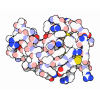[English] 日本語
 Yorodumi
Yorodumi- PDB-5cxv: Structure of the human M1 muscarinic acetylcholine receptor bound... -
+ Open data
Open data
- Basic information
Basic information
| Entry | Database: PDB / ID: 5cxv | ||||||
|---|---|---|---|---|---|---|---|
| Title | Structure of the human M1 muscarinic acetylcholine receptor bound to antagonist Tiotropium | ||||||
 Components Components |
| ||||||
 Keywords Keywords |  HYDROLASE / HYDROLASE /  Acetylcholine / Acetylcholine /  Allosteric Regulation / Allosteric Regulation /  Carrier Proteins / Cholinergic Antagonists / Tiotropium Receptor / Muscarinic M1 / Carrier Proteins / Cholinergic Antagonists / Tiotropium Receptor / Muscarinic M1 /  GPCR / Subtype selectivity GPCR / Subtype selectivity | ||||||
| Function / homology |  Function and homology information Function and homology informationsaliva secretion / regulation of glial cell proliferation / positive regulation of monoatomic ion transport /  Muscarinic acetylcholine receptors / phospholipase C-activating G protein-coupled acetylcholine receptor signaling pathway / G protein-coupled acetylcholine receptor activity / neuromuscular synaptic transmission / cholinergic synapse / adenylate cyclase-inhibiting G protein-coupled acetylcholine receptor signaling pathway / positive regulation of intracellular protein transport ...saliva secretion / regulation of glial cell proliferation / positive regulation of monoatomic ion transport / Muscarinic acetylcholine receptors / phospholipase C-activating G protein-coupled acetylcholine receptor signaling pathway / G protein-coupled acetylcholine receptor activity / neuromuscular synaptic transmission / cholinergic synapse / adenylate cyclase-inhibiting G protein-coupled acetylcholine receptor signaling pathway / positive regulation of intracellular protein transport ...saliva secretion / regulation of glial cell proliferation / positive regulation of monoatomic ion transport /  Muscarinic acetylcholine receptors / phospholipase C-activating G protein-coupled acetylcholine receptor signaling pathway / G protein-coupled acetylcholine receptor activity / neuromuscular synaptic transmission / cholinergic synapse / adenylate cyclase-inhibiting G protein-coupled acetylcholine receptor signaling pathway / positive regulation of intracellular protein transport / phosphatidylinositol phospholipase C activity / G protein-coupled serotonin receptor activity / protein kinase C-activating G protein-coupled receptor signaling pathway / regulation of locomotion / postsynaptic modulation of chemical synaptic transmission / G protein-coupled receptor signaling pathway, coupled to cyclic nucleotide second messenger / regulation of postsynaptic membrane potential / axon terminus / viral release from host cell by cytolysis / peptidoglycan catabolic process / postsynaptic density membrane / Schaffer collateral - CA1 synapse / G protein-coupled acetylcholine receptor signaling pathway / Muscarinic acetylcholine receptors / phospholipase C-activating G protein-coupled acetylcholine receptor signaling pathway / G protein-coupled acetylcholine receptor activity / neuromuscular synaptic transmission / cholinergic synapse / adenylate cyclase-inhibiting G protein-coupled acetylcholine receptor signaling pathway / positive regulation of intracellular protein transport / phosphatidylinositol phospholipase C activity / G protein-coupled serotonin receptor activity / protein kinase C-activating G protein-coupled receptor signaling pathway / regulation of locomotion / postsynaptic modulation of chemical synaptic transmission / G protein-coupled receptor signaling pathway, coupled to cyclic nucleotide second messenger / regulation of postsynaptic membrane potential / axon terminus / viral release from host cell by cytolysis / peptidoglycan catabolic process / postsynaptic density membrane / Schaffer collateral - CA1 synapse / G protein-coupled acetylcholine receptor signaling pathway /  cognition / cell wall macromolecule catabolic process / cognition / cell wall macromolecule catabolic process /  lysozyme / lysozyme /  presynaptic membrane / presynaptic membrane /  lysozyme activity / lysozyme activity /  nervous system development / chemical synaptic transmission / G alpha (q) signalling events / host cell cytoplasm / defense response to bacterium / G protein-coupled receptor signaling pathway / nervous system development / chemical synaptic transmission / G alpha (q) signalling events / host cell cytoplasm / defense response to bacterium / G protein-coupled receptor signaling pathway /  dendrite / dendrite /  synapse / glutamatergic synapse / synapse / glutamatergic synapse /  signal transduction / signal transduction /  membrane / membrane /  plasma membrane plasma membraneSimilarity search - Function | ||||||
| Biological species |   Homo sapiens (human) Homo sapiens (human)  Enterobacteria phage T4 (virus) Enterobacteria phage T4 (virus) | ||||||
| Method |  X-RAY DIFFRACTION / X-RAY DIFFRACTION /  SYNCHROTRON / SYNCHROTRON /  MOLECULAR REPLACEMENT / Resolution: 2.7 Å MOLECULAR REPLACEMENT / Resolution: 2.7 Å | ||||||
 Authors Authors | Sun, B. / Feng, D. / Li, X. / Kobilka, T.S. / Kobilka, B.K. | ||||||
 Citation Citation |  Journal: Nature / Year: 2016 Journal: Nature / Year: 2016Title: Crystal structures of the M1 and M4 muscarinic acetylcholine receptors. Authors: Thal, D.M. / Sun, B. / Feng, D. / Nawaratne, V. / Leach, K. / Felder, C.C. / Bures, M.G. / Evans, D.A. / Weis, W.I. / Bachhawat, P. / Kobilka, T.S. / Sexton, P.M. / Kobilka, B.K. / Christopoulos, A. | ||||||
| History |
|
- Structure visualization
Structure visualization
| Structure viewer | Molecule:  Molmil Molmil Jmol/JSmol Jmol/JSmol |
|---|
- Downloads & links
Downloads & links
- Download
Download
| PDBx/mmCIF format |  5cxv.cif.gz 5cxv.cif.gz | 103 KB | Display |  PDBx/mmCIF format PDBx/mmCIF format |
|---|---|---|---|---|
| PDB format |  pdb5cxv.ent.gz pdb5cxv.ent.gz | 81.1 KB | Display |  PDB format PDB format |
| PDBx/mmJSON format |  5cxv.json.gz 5cxv.json.gz | Tree view |  PDBx/mmJSON format PDBx/mmJSON format | |
| Others |  Other downloads Other downloads |
-Validation report
| Arichive directory |  https://data.pdbj.org/pub/pdb/validation_reports/cx/5cxv https://data.pdbj.org/pub/pdb/validation_reports/cx/5cxv ftp://data.pdbj.org/pub/pdb/validation_reports/cx/5cxv ftp://data.pdbj.org/pub/pdb/validation_reports/cx/5cxv | HTTPS FTP |
|---|
-Related structure data
- Links
Links
- Assembly
Assembly
| Deposited unit | 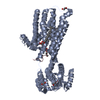
| ||||||||
|---|---|---|---|---|---|---|---|---|---|
| 1 |
| ||||||||
| Unit cell |
|
- Components
Components
-Protein / Protein/peptide , 2 types, 2 molecules AC
| #1: Protein | Mass: 58653.375 Da / Num. of mol.: 1 Mutation: N110Q, C1052T, C1095A,N110Q, C1052T, C1095A,N110Q, C1052T, C1095A Source method: isolated from a genetically manipulated source Source: (gene. exp.)   Homo sapiens (human), (gene. exp.) Homo sapiens (human), (gene. exp.)   Enterobacteria phage T4 (virus) Enterobacteria phage T4 (virus)Gene: CHRM1 / Production host:   Spodoptera frugiperda (fall armyworm) / References: UniProt: P11229, UniProt: P00720, Spodoptera frugiperda (fall armyworm) / References: UniProt: P11229, UniProt: P00720,  lysozyme lysozyme |
|---|---|
| #2: Protein/peptide | Mass: 885.808 Da / Num. of mol.: 1 / Source method: obtained synthetically / Source: (synth.)   Enterobacteria phage T4 (virus) Enterobacteria phage T4 (virus) |
-Non-polymers , 6 types, 17 molecules 


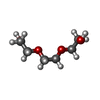







| #3: Chemical | ChemComp-0HK / ( Tiotropium bromide Tiotropium bromide | ||||||
|---|---|---|---|---|---|---|---|
| #4: Chemical | ChemComp-Y01 / | ||||||
| #5: Chemical |  Ethylene glycol Ethylene glycol#6: Chemical | ChemComp-PGE / |  Polyethylene glycol Polyethylene glycol#7: Chemical | ChemComp-GOL / |  Glycerol Glycerol#8: Water | ChemComp-HOH / |  Water Water |
-Experimental details
-Experiment
| Experiment | Method:  X-RAY DIFFRACTION / Number of used crystals: 1 X-RAY DIFFRACTION / Number of used crystals: 1 |
|---|
- Sample preparation
Sample preparation
| Crystal | Density Matthews: 3.09 Å3/Da / Density % sol: 60.21 % |
|---|---|
Crystal grow | Temperature: 293 K / Method: lipidic cubic phase Details: 33% PEG 300, 100 mM sodium acetate, and 100 mM Bis-Tris Propane (pH 8.0) PH range: 8 |
-Data collection
| Diffraction | Mean temperature: 78 K | ||||||||||||||||||||||||||||||||||||||||||||||||||||||||||||||||||
|---|---|---|---|---|---|---|---|---|---|---|---|---|---|---|---|---|---|---|---|---|---|---|---|---|---|---|---|---|---|---|---|---|---|---|---|---|---|---|---|---|---|---|---|---|---|---|---|---|---|---|---|---|---|---|---|---|---|---|---|---|---|---|---|---|---|---|---|
| Diffraction source | Source:  SYNCHROTRON / Site: SYNCHROTRON / Site:  APS APS  / Beamline: 23-ID-D / Wavelength: 1.033 Å / Beamline: 23-ID-D / Wavelength: 1.033 Å | ||||||||||||||||||||||||||||||||||||||||||||||||||||||||||||||||||
| Detector | Type: MARMOSAIC 300 mm CCD / Detector: CCD / Date: Nov 11, 2011 | ||||||||||||||||||||||||||||||||||||||||||||||||||||||||||||||||||
| Radiation | Protocol: SINGLE WAVELENGTH / Monochromatic (M) / Laue (L): M / Scattering type: x-ray | ||||||||||||||||||||||||||||||||||||||||||||||||||||||||||||||||||
| Radiation wavelength | Wavelength : 1.033 Å / Relative weight: 1 : 1.033 Å / Relative weight: 1 | ||||||||||||||||||||||||||||||||||||||||||||||||||||||||||||||||||
| Reflection | Resolution: 2.7→30 Å / Num. obs: 20402 / % possible obs: 97.1 % / Redundancy: 4.3 % / Rmerge(I) obs: 0.155 / Χ2: 1.292 / Net I/av σ(I): 8.745 / Net I/σ(I): 7 / Num. measured all: 87751 | ||||||||||||||||||||||||||||||||||||||||||||||||||||||||||||||||||
| Reflection shell | Diffraction-ID: 1 / Rejects: 0
|
- Processing
Processing
| Software |
| |||||||||||||||||||||
|---|---|---|---|---|---|---|---|---|---|---|---|---|---|---|---|---|---|---|---|---|---|---|
| Refinement | Method to determine structure : :  MOLECULAR REPLACEMENT / Resolution: 2.7→30 Å / Cor.coef. Fo:Fc: 0.934 / Cor.coef. Fo:Fc free: 0.9 / SU B: 0.012 / SU ML: 0 / Cross valid method: THROUGHOUT / ESU R: 0.278 / ESU R Free: 0.339 / Stereochemistry target values: MAXIMUM LIKELIHOOD MOLECULAR REPLACEMENT / Resolution: 2.7→30 Å / Cor.coef. Fo:Fc: 0.934 / Cor.coef. Fo:Fc free: 0.9 / SU B: 0.012 / SU ML: 0 / Cross valid method: THROUGHOUT / ESU R: 0.278 / ESU R Free: 0.339 / Stereochemistry target values: MAXIMUM LIKELIHOOD
| |||||||||||||||||||||
| Solvent computation | Ion probe radii: 0.8 Å / Shrinkage radii: 0.8 Å / VDW probe radii: 1.2 Å / Solvent model: BABINET MODEL WITH MASK | |||||||||||||||||||||
| Displacement parameters | Biso mean: 73.383 Å2
| |||||||||||||||||||||
| Refinement step | Cycle: LAST / Resolution: 2.7→30 Å
| |||||||||||||||||||||
| LS refinement shell | Resolution: 2.698→2.768 Å / Total num. of bins used: 20
|
 Movie
Movie Controller
Controller






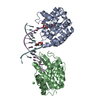
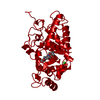

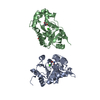
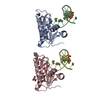


 PDBj
PDBj